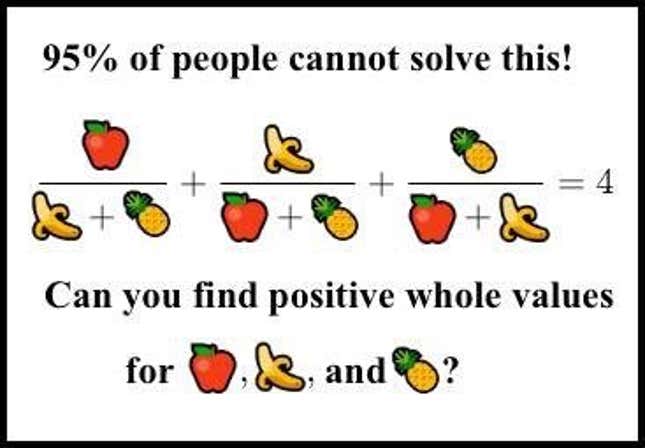Every few months, a math problem goes viral on social media. Disappointingly often, it lacks mathematical meat. It seems over half of them boil down to the order of operations. Some tweet will get thousands of likes claiming that the Internet is divided over an arithmetic problem admire: what does 6÷2(1+2) equal? It’s fine if people don’t recall how to evaluate expressions admire this. But it’s not so interesting when you just have to Google the order of operations and follow the instructions (it equals 9).
In a similar vein, you may have seen “fruit math” memes circulating across your feed in which simple systems of equations have “x” and “y” replaced with bananas and pineapples, usually captioned with “Only geniuses can overcome” or “Only 1% of MIT graduates got this.” Here’s a hilarious prank that some Internet devil cooked up to lash out at frivolous math clickbait:

I’ll save you some time and spoil the solution:
Apple = 154476802108746166441951315019919837485664325669565431700026634898253202035277999,
Banana = 36875131794129999827197811565225474825492979968971970996283137471637224634055579,
Pineapple =
4373612677928697257861252602371390152816537558161613618621437993378423467772036
Indeed, 95% of people cannot overcome this. Despite its simplistic appearance, the problem requires highly advanced math and wasn’t solved until 2014.
This week’s puzzle comes from a real problem on a math evaluate given to students in Singapore. It is neither trivial nor a prank, but it went viral for causing rifts among solvers. It’s a tricky exercise in logic unlike any exam problem from my school days.
Did you miss last week’s puzzle? Check it out here, and find its solution at the bottom of today’s article. Be careful not to read too far ahead if you haven’t solved last week’s yet!
Puzzle #22: Cheryl’s birthday
Albert and Bernard just became friends with Cheryl, and they want to know when her birthday is. Cheryl gives them a list of 10 possible dates.
May 15, May 16, May 19
June 17, June 18
July 14, July 16
August 14, August 15, August 17
Cheryl then tells Albert the month of her birthday and Bernard the day of her birthday separately. Then the following conversation takes place:
Albert: I don’t know when Cheryl’s birthday is, but I know that Bernard also does not know.
Bernard: At first I didn’t know when Cheryl’s birthday is, but I know now.
Albert: Then I also know when Cheryl’s birthday is.
When is Cheryl’s birthday?
You’ll be relieved to hear that the solution does not involve 80-digit numbers. It does, however, demand some careful logic.
I’ll be back next week with the solution and a new puzzle. Do you know a cool puzzle that I should cover here? Message me on Twitter @JackPMurtagh or email me at gizmodopuzzle@gmail.com
Solution to Puzzle #21: Impossible Geography
How did you steer last week’s weird geography quiz? If you find the first two answers hard to believe, play around with Google Earth to see them for yourself. Shout-out to Executor32 for nailing all three.
- Which U.S. state is closest to Africa?
Many people think Florida, but it’s actually Maine by a long shot. Africa sits more north than you might picture. Executor32 points out that if Puerto Rico ever became a U.S. state, it would beat Maine in this contest, because Puerto Rico sits east of Maine.
- If you fly due south from Key West, Florida, which South American country will you hit first?
You actually won’t pass over any South American country if you fly south from Key West. You’ll soar west of the whole continent.
- I am in an East Coast U.S. state and I call my friend who is in a West Coast U.S. state. It is exactly the same time of day for both of us. How is this possible?
Typically, there’s a three-hour time difference between East Coast and West Coast states. We’ll close this gap one hour at a time. Although Florida is an East Coast state, the part of the panhandle under Alabama actually dips into the central time zone. Likewise, an eastern swath of Oregon (a West Coast state) observes mountain time. So there are regions in Florida and Oregon whose clocks only differ by an hour. To bridge the final gap, I place the call on Daylight Savings Time in the fall when the clocks roll back an hour. At 1:59 am in parts of Florida on this day (just before the clock falls back), it will be 12:59 am in parts of Oregon. In the next minute, Florida will fall back and it will be 1:00 am in both places. I then have an hour to place my call before Oregon falls back. This phone call can only occur within this specific hour of the year between these two specific regions of the country.

